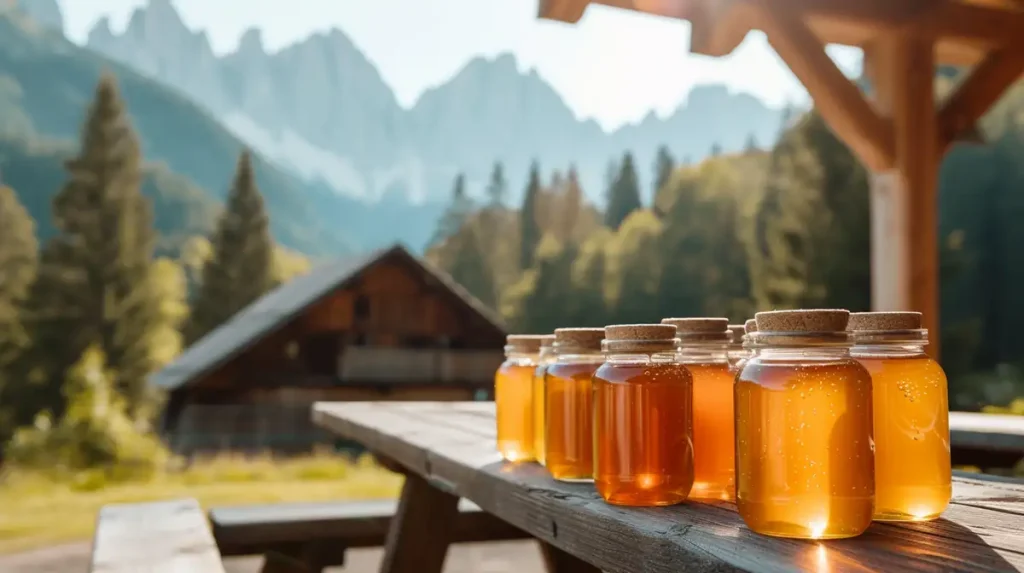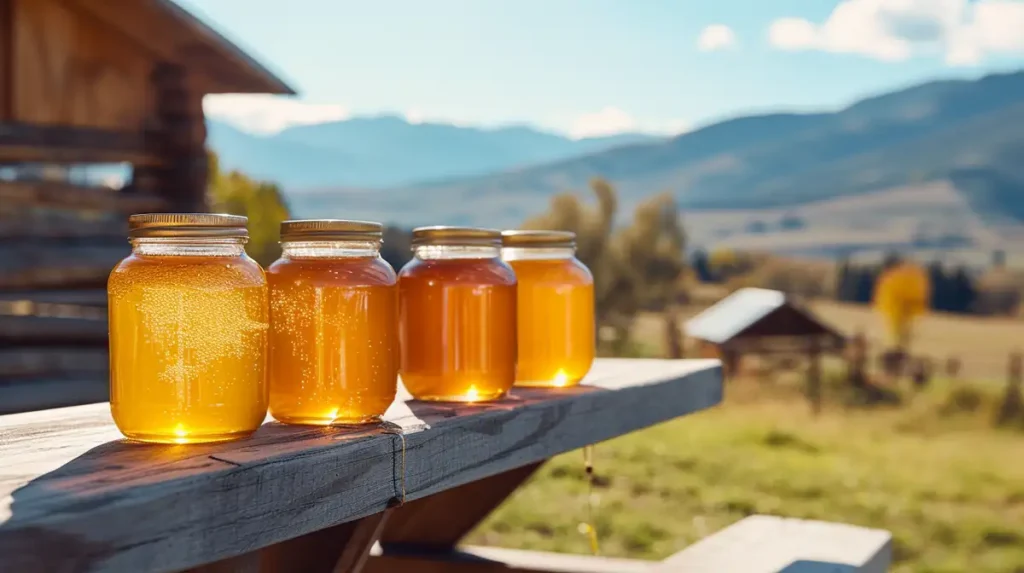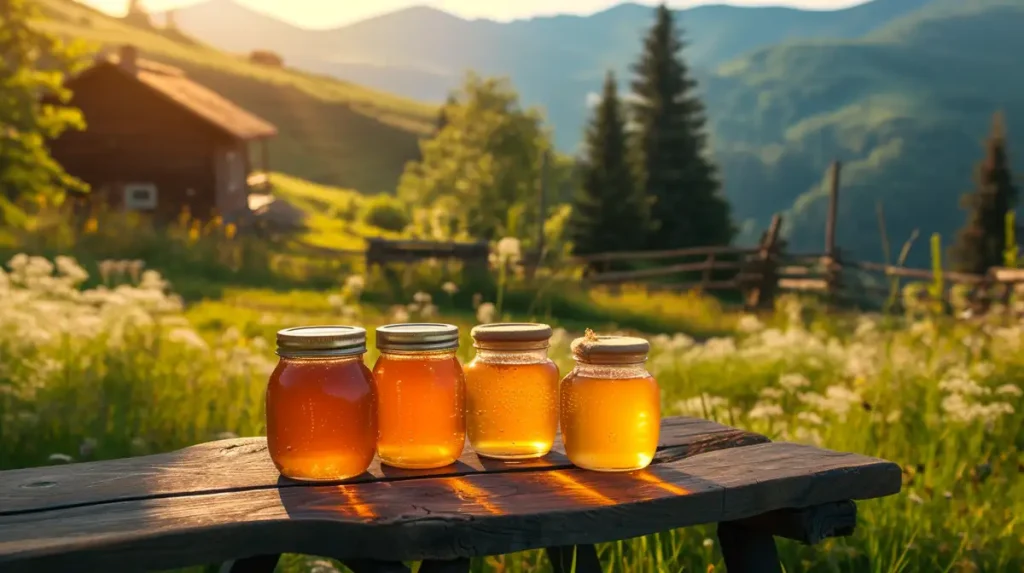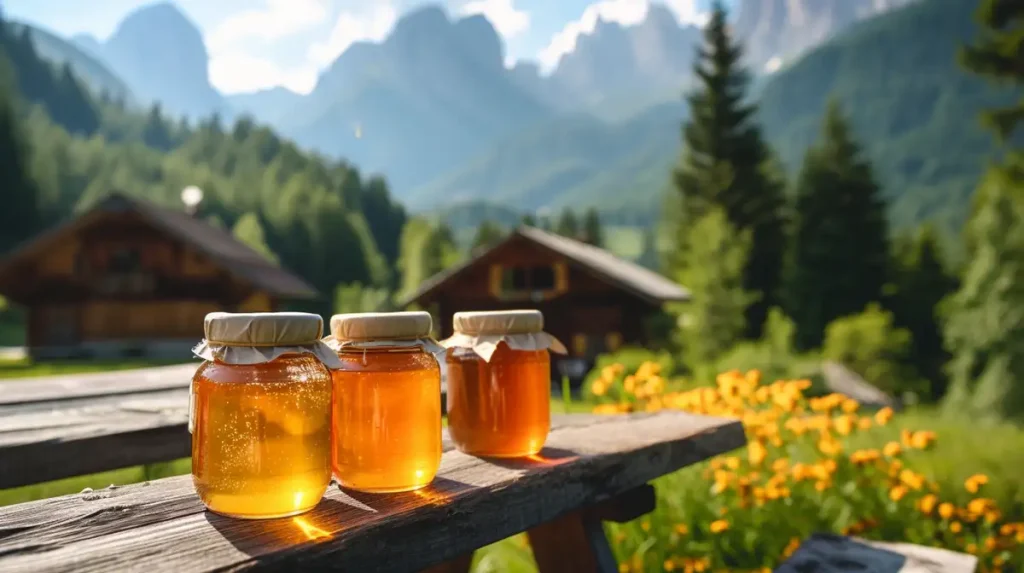One of the most important aspects of a beekeeper’s work is the production and harvesting of honey. However, not all honey is created equal. In fact, there are countless different types of honey, each with its own unique flavor, texture, and medicinal properties. This article not only presents you with our mammoth list of different honeys, but thereafter we will also explore the differences between monofloral, polyfloral, and varietal honeys, and discuss how to market and sell them effectively.
35 Different Types Of Honey
- Clover honey – This is a popular type of honey that is made from the nectar of clover flowers. It has a light, sweet flavor and is commonly used as a sweetener.
- Manuka honey – This honey is made by bees that feed on the nectar of the Manuka tree, which is native to New Zealand. It is known for its antibacterial properties and is often used in medical applications.
- Acacia honey – This honey is made from the nectar of the acacia tree, which is native to Africa and parts of Asia. It has a light, delicate flavor and is often used in baking.
- Buckwheat honey – This honey is made from the nectar of the buckwheat flower, and has a dark, strong flavor. It is often used as a natural remedy for coughs and sore throats.
- Orange blossom honey – This honey is made from the nectar of orange blossoms, and has a light, citrusy flavor. It is often used in tea and other beverages.
- Wildflower honey – This honey is made from the nectar of a variety of wildflowers and can have a range of flavors depending on the flowers that were used.
- Eucalyptus honey – This honey is made from the nectar of eucalyptus trees and has a slightly medicinal flavor. It is often used as a natural remedy for respiratory issues.
- Lavender honey – This honey is made from the nectar of lavender flowers and has a floral, delicate flavor. It is often used in tea and other beverages.
- Sage honey – This honey is made from the nectar of sage flowers and has a strong, herbal flavor. It is often used in marinades and dressings.
- Tupelo honey – This honey is made from the nectar of the tupelo tree, which is found in the southeastern United States. It has a light, sweet flavor and is prized for its rarity.
- Chestnut honey – This honey is made from the nectar of chestnut trees and has a dark, rich flavor with a slightly bitter aftertaste. It is often used in savory dishes.
- Heather honey – This honey is made from the nectar of heather flowers and has a strong, floral flavor. It is often used in baking and as a sweetener for tea.
- Linden honey – This honey is made from the nectar of linden trees and has a light, minty flavor. It is often used in tea and other beverages.
- Pine honey – This honey is made from the nectar of pine trees and has a thick, syrupy texture and a strong, woody flavor. It is often used in marinades and sauces.
- Blueberry honey – This honey is made from the nectar of blueberry flowers and has a light, fruity flavor with a subtle hint of blueberry. It is often used in baking and as a topping for pancakes and waffles.
- Rosemary honey – This honey is made from the nectar of rosemary flowers and has a strong, herbal flavor. It is often used in savory dishes and marinades.
- Sunflower honey – This honey is made from the nectar of sunflower flowers and has a light, nutty flavor. It is often used in baking and as a topping for toast and muffins.
- Thyme honey – This honey is made from the nectar of thyme flowers and has a strong, herbal flavor. It is often used in marinades and dressings.
- Raspberry honey – This honey is made from the nectar of raspberry flowers and has a light, fruity flavor with a subtle hint of raspberry. It is often used in baking and as a topping for yogurt and oatmeal.
- Apple honey – This honey is made from the nectar of apple blossoms and has a light, fruity flavor with a subtle hint of apple. It is often used in baking and as a sweetener for tea and other beverages.
- Mesquite honey – This honey is made from the nectar of mesquite flowers and has a strong, smoky flavor. It is often used in barbecue sauces and marinades.
- Sourwood honey – This honey is made from the nectar of sourwood trees, which are found in the southeastern United States. It has a light, sweet flavor with a subtle hint of caramel.
- Avocado honey – This honey is made from the nectar of avocado flowers and has a rich, buttery flavor. It is often used as a natural sweetener for smoothies and baked goods.
- Blackberry honey – This honey is made from the nectar of blackberry flowers and has a light, fruity flavor with a subtle hint of blackberry. It is often used in baking and as a topping for yogurt and oatmeal.
- Carob honey – This honey is made from the nectar of carob trees and has a rich, chocolaty flavor. It is often used as a natural sweetener for desserts and hot beverages.
- Chestnut honey – This honey is made from the nectar of chestnut trees and has a dark, robust flavor with a slightly bitter aftertaste. It is often used in savory dishes and as a topping for cheese.
- Citrus honey – This honey is made from the nectar of citrus trees and has a light, fruity flavor with a subtle hint of citrus. It is often used as a sweetener for tea and other beverages.
- Coriander honey – This honey is made from the nectar of coriander flowers and has a light, floral flavor with a subtle hint of spice. It is often used in marinades and dressings.
- Fireweed honey – This honey is made from the nectar of fireweed flowers and has a light, delicate flavor. It is often used in tea and as a natural sweetener for desserts.
- Leatherwood honey – This honey is made from the nectar of leatherwood trees, which are found in Tasmania, Australia. It has a strong, distinctive flavor with a hint of spice.
- Macadamia honey – This honey is made from the nectar of macadamia nut flowers and has a light, nutty flavor. It is often used as a natural sweetener for smoothies and baked goods.
- Sour cherry honey – This honey is made from the nectar of sour cherry blossoms and has a tart, fruity flavor. It is often used in baking and as a topping for yogurt and oatmeal.
- Tualang honey – This honey is made by bees that collect nectar from the flowers of the Tualang tree, which is found in Southeast Asia. It has a strong, medicinal flavor and is often used for its health benefits.
- Ulmo honey – This honey is made from the nectar of Ulmo trees, which are found in Chile. It has a smooth, creamy texture and a light, floral flavor.
- Wild thyme honey – This honey is made from the nectar of wild thyme flowers and has a strong, herbal flavor with a hint of sweetness. It is often used in marinades and dressings.

Monofloral Honey
Monofloral honey is a type of honey that is made by bees that have gathered nectar from a single type of flower or plant. This results in a honey that has a distinct flavor and aroma that is unique to that particular plant species. The flavor of monofloral honey can vary widely depending on the type of plant the bees have harvested nectar from. For example, clover honey has a mild, sweet taste, while orange blossom honey has a citrusy flavor.
To produce monofloral honey, beekeepers must carefully manage their hives to ensure that the bees are primarily gathering nectar from a single plant species. This requires placing the hives near fields or areas where the specific plants are in bloom. This type of honey can be more difficult to produce than other types of honey, as the bees must be carefully monitored to ensure that they are only collecting nectar from the desired plant species.
Once the honey has been harvested, it can be marketed and sold as a premium product with unique flavor characteristics. Monofloral honey is often used in cooking and baking, as it can add a distinct and complex flavor to recipes. It can also be used in natural remedies and skincare products, as it is believed to have a range of health benefits.
When marketing monofloral honey, it’s important to emphasize the unique flavor profile of the honey and the specific type of plant that the bees have harvested nectar from. This can help to differentiate your product from other types of honey on the market. Monofloral honey can be sold online, in specialty food stores, and at farmer’s markets. By emphasizing the unique characteristics of your honey and targeting the right audience, you can build a loyal customer base and increase the profitability of your business.

Polyfloral Honey
Polyfloral honey, also known as wildflower honey, is made by bees that have gathered nectar from a variety of different types of flowers and plants. As a result, polyfloral honey has a more complex flavor profile than monofloral honey with a darker color and a richer, more robust taste. It may also have a slightly bitter taste, depending on the plants the bees have visited.
To produce polyfloral honey, beekeepers must ensure that their bees have access to a wide variety of flowering plants in their foraging range. This allows the bees to collect nectar from a diverse range of plants, resulting in a honey with a unique flavor that reflects the local flora.
Polyfloral honey is often marketed as a natural, unprocessed product with a range of medicinal properties. It is believed to have antibacterial and anti-inflammatory properties and is often used in natural remedies for everything from allergies to sore throats. Polyfloral honey is also a popular ingredient in cooking and baking, as its complex flavor profile can add depth and nuance to recipes. In addition, it can be used as an ingredient in natural skincare products as it is believed to have moisturizing and anti-aging properties.
When marketing polyfloral honey, it’s important to emphasize the natural, unprocessed nature of the product as well as its unique flavor profile. Polyfloral honey can be sold online, in specialty food stores, and at farmer’s markets. Emphasize the natural, healthful qualities of the honey and target the right audience.
Varietal Honey
Varietal honey is a type of honey that is made from the nectar of a specific type of plant, but unlike monofloral honey it is produced in a particular geographic region. This results in a honey that has a unique flavor and aroma that is specific to that region. Examples of varietal honey include Tupelo honey, which is produced in the southeastern United States, and Manuka honey, which is produced in New Zealand.
To produce varietal honey, beekeepers need to ensure that their bees are primarily gathering nectar from a specific type of plant. This requires placing the hives in close to the fields or areas where the desired plants are in bloom.
Once the honey has been harvested, it can be marketed and sold as a premium product with unique flavor characteristics. Varietal honey is often used in cooking and baking, as it too can add a distinct and complex flavor to recipes. It is also valued for its medicinal properties as well, as some types of varietal honey are believed to have antibacterial and anti-inflammatory properties.
- Carter, Anthony (Author)
- English (Publication Language)
- 194 Pages - 02/28/2024 (Publication Date) - Independently published (Publisher)
When marketing varietal honey, it’s important to emphasize the unique flavor profile of the honey and the specific region in which it was produced. This can help to differentiate your product from other types of honey on the market. Varietal honey can be sold online, in specialty food stores, and at farmer’s markets.

Marketing and Selling Honey
Once you’ve harvested your honey, the next step is to market and sell it effectively. One of the most important aspects of selling honey is branding and packaging. Each type of honey has its own unique characteristics, and your branding and packaging should reflect that. For example, if you’re selling monofloral honey, you may want to use a label that highlights the specific type of plant the honey was made from.
Choosing the right packaging materials is also important. Glass jars are a popular choice for honey, as they are both attractive and practical. However, you may want to consider using different types of packaging for different types of honey. For example, varietal honey may be best suited to small, high-end jars with elegant packaging.
When it comes to selling honey, there are many options available. You can sell your honey online through your own website or through online marketplaces like Etsy or Amazon. You can also sell your honey in person at local farmer’s markets, craft fairs, or specialty food stores.
It’s important to market your honey to the right audience. For example, if you’re selling varietal honey, you may want to target high-end specialty food stores or health food stores. On the other hand, if you’re selling polyfloral honey, you may want to target farmers markets and community events.
Social media can also be a powerful tool for marketing honey. By using social media platforms like Facebook and Instagram, you can share photos of your honey, promote your brand, and connect with potential customers.
In addition to marketing your honey, it’s important to be transparent about your production methods and any certifications or awards you’ve received. This can help build trust with customers and increase the perceived value of your honey.
Different Types of Honey – Conclusion
As a beekeeper, understanding the different types of honey and how to market and sell them effectively is key to building a successful honey production business. By carefully managing your hives and using the right production techniques, you can produce high-quality honey with unique flavors and medicinal properties. By branding and packaging your honey effectively and marketing it to the right audience, you can build a loyal customer base and increase the profitability of your business.
Medical Disclaimer: The content provided in this blog post is for informational purposes only and is not intended as medical advice, or to replace the advice of a healthcare professional. Bee stings can cause allergic reactions in some individuals, which can be severe and require immediate medical attention. Similarly, consuming bee products, including honey, pollen, propolis, and royal jelly, can cause adverse reactions in people with specific allergies or intolerances. If you experience any negative reactions or are unsure about your allergies, consult with a healthcare provider promptly. The views expressed in this article are based on current knowledge and do not cover all possible health implications. Always seek the advice of your physician or another qualified health provider with any questions you may have regarding a medical condition or before starting any new treatment.
Last update on 2024-04-17 / Affiliate links / Images from Amazon Product Advertising API


